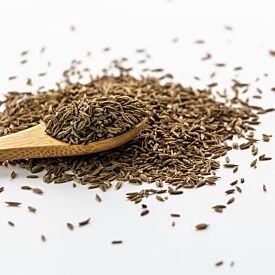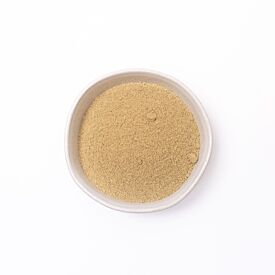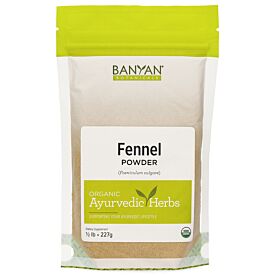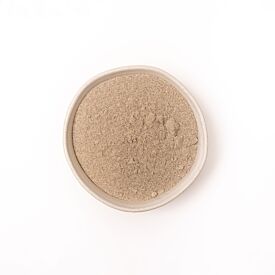The Art of Using Ayurvedic Spices
I have a cabinet full of Ayurvedic spices. Each time I get ready to cook a meal, I get so much joy from seeing all the opportunities inside these little jars. The golden color of turmeric powder, the sweetness of fennel seed—everything is just waiting to come alive and nurture my health from the inside out.
This time of year, when the weather is cooler and vata and kapha doshas are more prevalent in our bodies and the environment, use the power of spices to stay in balance. Knowing how to use spices to support digestion and bring balance to a meal will make it easy to feel healthy in your body and mind. Indeed, spices are what turn food into medicine.
But spices offer so much more than digestive support. One of the best gifts they offer is making food taste delicious. When food tastes great (and digests well), we feel satisfied to the core of our being. Cravings for foods that don’t serve us fall away naturally without effort.
Truly, spices give us the opportunity to engage all of our senses—not just taste. See the vibrancy of their color and the prana inside them. Touch the spices as you add them to your dish (I often use my clean hands to measure, it helps me be more intuitive about cooking), smell and hear them simmering in the ghee. See the act of cooking with spices as a practice in using your senses wisely and you’ll build a foundation for deep and lasting health.
Using Ayurvedic Spices for Balance, Taste, and Harmony
Every meal offers an opportunity to build a better relationship with your body and mind. Before you open your spice cabinet, tune in to what your body needs that day. Are you feeling the cold qualities of vata or kapha? It’s time to bring out warming spices (cumin, black pepper, mustard seed). When the weather is hot, or if you feel signs of pitta imbalance (internal heat, impatience, anger), reach for those spices that are more neutral or cooling (coriander, cardamom, fennel).
When you choose the spices for your meal, use them in balance. This is one of the key lessons I teach the students who attend my Ayurvedic chef training. Maintaining balance, which means using enough spice so that the food is lifted by the taste, but not so much so that one taste stands out in the finished product, is the goal of the skilled Ayurvedic chef.
Learning to use spice combinations is a science and an art. Have a playful attitude and be open to trying new things.
As you eat, keep a journal of what you used, how it tasted, and how you felt afterwards.
As you explore the world of spices, be sure not to let your imbalance drive your choices. Remember that when any one dosha is far out of balance, you may experience cravings for foods that will drive further imbalance. Practice satya, honesty, in your choices and use the Ayurvedic principle of “like increases like, the opposite brings balance” to choose spice combinations that will guide your healing journey.
 http://www.halepule.com/
http://www.halepule.com/
A Simple Dal for a Cold Day
I’ve included a simple dal recipe that uses three spices that taste lovely together. All of these spices have the pungent taste and provide a warming quality. These qualities make this dish perfect for this time of year when we are transitioning into kapha season.
This simple dal recipe includes:
- Cumin: This pungent and bitter spice dispels gas and balances all doshas, especially vata and kapha. It is a versatile spice that adds a delicious flavor to any dish.
- Fenugreek: This spice has pungent, astringent, sweet, and bitter rasa (taste) and is known to decrease vata and kapha (it can increase pitta if used in excess).
- Rosemary: This pungent herb is stimulating and warming. It can be drying, so use in small amounts if vata dosha is high.
Simple Dal Recipe
Serves 1–2
When you begin cooking, warm the spices in ghee or oil for a minute or two before adding other ingredients. You’ll know they are ready when the aroma comes up to meet you. This small step awakens the prana and makes the flavor come alive.
Ingredients:
- ⅓ cup split mung dal, rinsed and drained
- 1 ½ tablespoon ghee
- ¼ teaspoon salt
- Pinch of flaked kombu
- ¼ teaspoon cumin seed
- ¼ teaspoon fenugreek powder
- 8–10 strands fresh rosemary (use about 15–18 strands if dried)
- 1 cup water if using pressure cooker or 1 ½ cups water if using stovetop
Warm the ghee and add the salt, kombu, and spices. Simmer until the aroma comes up to meet you. Add the split mung, stir, and simmer 2–3 minutes. Add the water and stir. If you are using a pressure cooker, cover, bring to pressure and cook for 16 minutes, then let it come out of pressure on its own. If you are using a regular pot, bring to a simmer, reduce heat to low, and cook with a tightly fitting lid for 25–30 minutes until the water is mostly absorbed and the beans are broken down to a soupy consistency.
Stir and serve warm.













